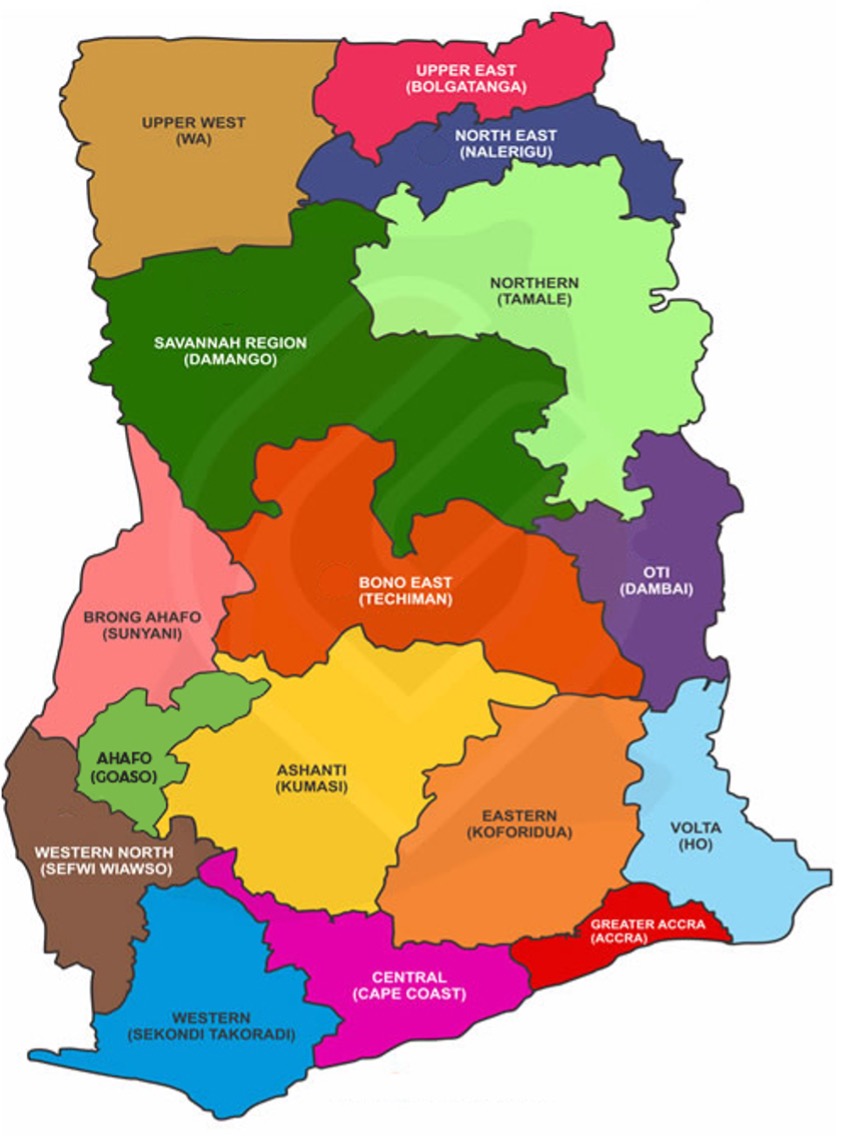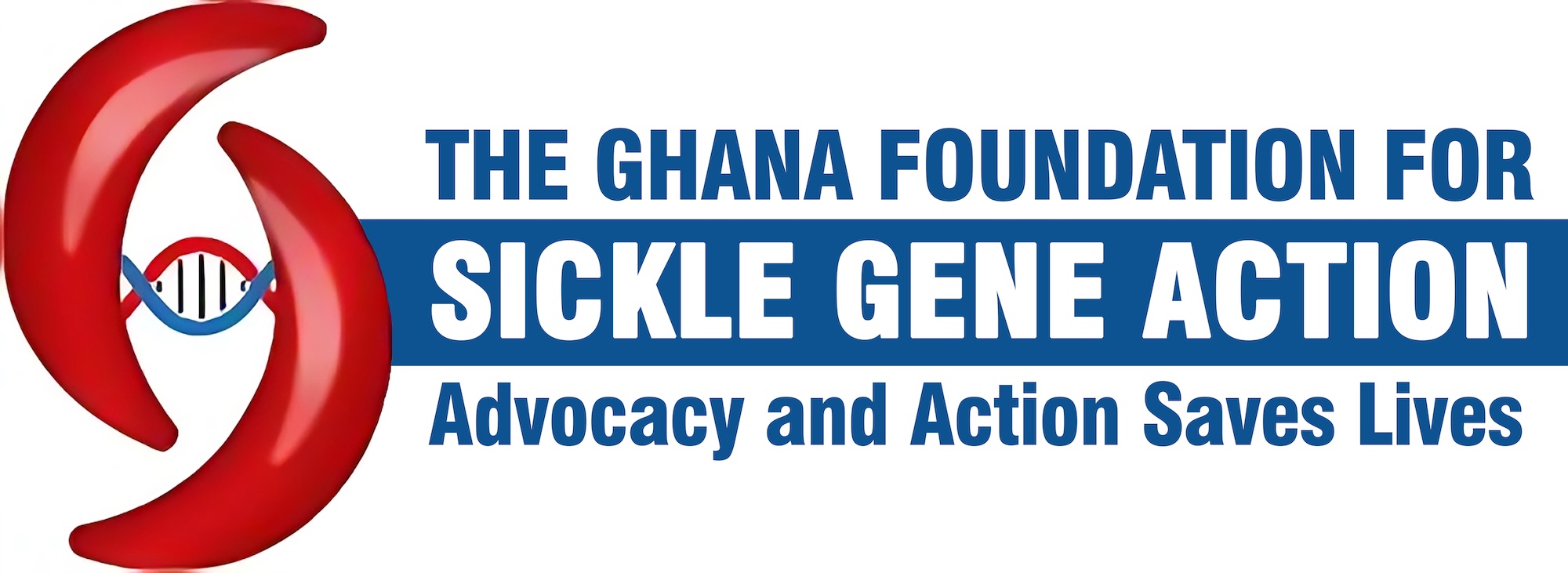2. We identify needs and advancements.
Our Aim
Our aim is to gather information that will:
• Show us where the gaps are between where we want to be and where we actually are.
• Show us where to place our priorities.
• Show us where barriers exist.
• Show us what opportunities there may be for solving problems.
• Enable us to acknowledge the efforts of our partners
Our Aim
• To establish ongoing communication with and support for our sickle cell partners in each of Ghana’s 16 regions.
Our Work
• Currently, we have visited 10 out of 16 regions in Ghana to raise awareness and educate the community, and to learn about what they need. Through these efforts, we have reached approximately 2 million people in communities across the country with our advocacy and needs assessment efforts.

A Map of Ghana
Needs (May 2022 Onward)
We need to restore the following components of the 30 years of national groundwork that has temporarily been lost or suspended after the unexpected loss of Prof. Ohene-Frempong’s leadership in May of 2022. See Our Groundwork
We need the newborn screening program that was functioning as of May 2022 to be restored and scaled up to provide this critical service for Ghana’s families.
✓ The National Newborn Screening Programme for Sickle Cell Disease (Est. 2010)
✓ The Newborn Screening Technical Advisory Committee (Est. 2010)
✓ The Regional Training Workshops in Sickle Cell Disease and Newborn Screening (Est. 2011)
✓ A National Coordinating Agency for the National Newborn Screening for Sickle Cell Disease (Est. 2010)
✓ A Detailed Plan for the National Newborn Screening for Sickle Cell Disease (Est. 2011)
✓ Active Newborn Screening Sites (39 sites as of 2016)
✓ The Genetic Education and Counselling for Sickle Cell Conditions in Ghana (GENECIS-Ghana) (Est. 2015)
✓ The Mobile Application for the Management of Newborn Screening – The NBS App (2018)
✓ The Newborn Screening Database and Comprehensive Data – (1992-2022)
This includes restoration of The Ahodwo Program [pronounced A-HU(n)-jo, established by the the Sickle Cell Foundation of Ghana (SCFG), a partner in the Public-Private Partnership was tasked to develop the Ghana-Novartis Hydroxyurea-for-SCD Program.
✓ The Hydroxyurea Treatment Protocol
✓ The Ahodwo Program App
✓ Hydroxyurea Treatment Teams at Centres Around Ghana
✓ The Hydroxyurea Steering Committee
✓ The Hydroxyurea Monitoring and Evaluation Program
✓ American Society of Hematology 2020 guidelines for sickle cell disease - Click To Read
✓ Stroke Prevalence in Children With Sickle Cell Disease in Sub-Saharan Africa - Click To Read
✓ Stroke in Sub-Saharan Africa - Click To Read
The SPARCo team, led by Ghana’s Prof. Ohene-Frempong, focus on recommendations for:
✓ Diagnosis
✓ Health Maintenance and Preventive Therapy
✓ Screening for Specific Complications
✓ Special Management Protocols
The Center for Clinical Genetics at Korle Bu Teaching Hospital in Accra has provided a medical home for their large numbers of patients with SCD in Accra. The proposed Kumasi Center has been under construction to serve a similar purpose for patients in Kumasi and surrounding areas.
Upon completion, the Center will provide:
✓ clinical care
✓ education and training
✓ a base for Africa-centered SCD research
Advancements (May 2022 Onward)
In spite of the loss of Prof. Ohene-Frempong’s 30 years of leadership due to his unexpected passing in 2022, Ghana’s policy makers, healthcare clinicians and researchers, and SCD NGOs and Associations continue to work to raise awareness and improve the treatment and care of people living with sickle cell disease in Ghana.
This includes:
✓ “PEN” stands for Package of Essential Noncommunicable Disease (NCD) Interventions.
✓ “PEN” addresses NCDs like cardiovascular diseases, cancer, chronic respiratory diseases, and diabetes.
✓ “PEN-Plus” builds on the World Health Organization’s (WHO’s) PEN Program by specifically focusing on even more complex and severe conditions like sickle cell disease.
✓ In November 2024, the Ghana Non-Communicable Diseases and Injuries (NCDI) Poverty Commission held its kickoff meeting to begin implementing the World Health Organizations (WHO’s) PEN-Plus Program.
✓ The purpose of the program is to expand the diagnosis and treatment of severe, chronic noncommunicable diseases in rural, impoverished areas of low and middle income countries.
Funded in partnership with Novartis, the 5-year “National Strategy for SCD” (2022-2028) is expected to prevent and control the disease burden through compre¬hensive and coordinated health¬care services, research and public awareness in order to reduce stigma and discrimination.
Significant Gatherings of Sickle Cell Disease Stakeholders
Gatherings of a range of stakeholders can result in both immediate and ultimate benefits for Sickle cell Warriors and their families.
Specifically:
-
Networking Opportunities
Connecting with industry leaders, researchers, and professionals to foster collaborations.
-
Knowledge Sharing
Gaining insights from expert speakers and panel discussions on the latest health trends and research.
-
Exposure to Innovations
Discovering new technologies and solutions that can improve patient care and health outcomes.
-
Professional Development
Attending workshops and sessions that enhance skills and knowledge in specific health areas.
-
Policy Influence
Engaging in discussions that shape health policies and practices at local, national, and global levels.
-
Cross-Disciplinary Collaboration
Encouraging partnerships between different health sectors, including public health, academia, and industry.
The Theme: “Transforming Sickle Cell Care with Global Strategies and Innovation”
Outcomes:
✓ As part of the events marking the 20th Celebration a leading telecommunications company in Ghana, AT, formerly AirtelTigo donated 20,000 cedis to the unit.
✓ The donation would made it possible to expand the ASCD Unit’s reach and subsidize treatment costs for underprivileged families.
The Theme: “Working Together to Reduce the Burden of Sickle Cell Disease: Leaving No One Behind”
Participants:
The Congress brought together stakeholders from across the world
✓ healthcare professionals
✓ researchers
✓ patients
✓ families/caregivers
✓ advocates
✓ industry leaders
✓ policymakers
The Goal : To “double efforts to develop policies and systems changes to implement effective, affordable, and scalable interventions that reach people with SCD wherever they live, leaving no one behind”.
The Theme: “The Current State of Sickle Cell Disease in Ghana: Progress Made, Challenges, and the Way Forward.”,
Participants:
✓ Selected sickle cell non-profit organizations
✓ Patients
✓ Caregivers
✓ Ghana Health Service
✓ Clinton Health Access Initiative
✓ Ministry of Health
✓ The West African Genetic medicine Center (WAGMC)
✓ Korle Bu Teaching Hospital Pediatric Clinic
✓ National Health Insurance Authority
The Goal:
✓ To address key components of Ghana’s Strategic Plan for Sickle cell Disease
✓ To shine a light on efforts by key stakeholder that align with the National Strategy
✓ To examine the prevailing challenges
✓ To outline actionable steps for future progress
